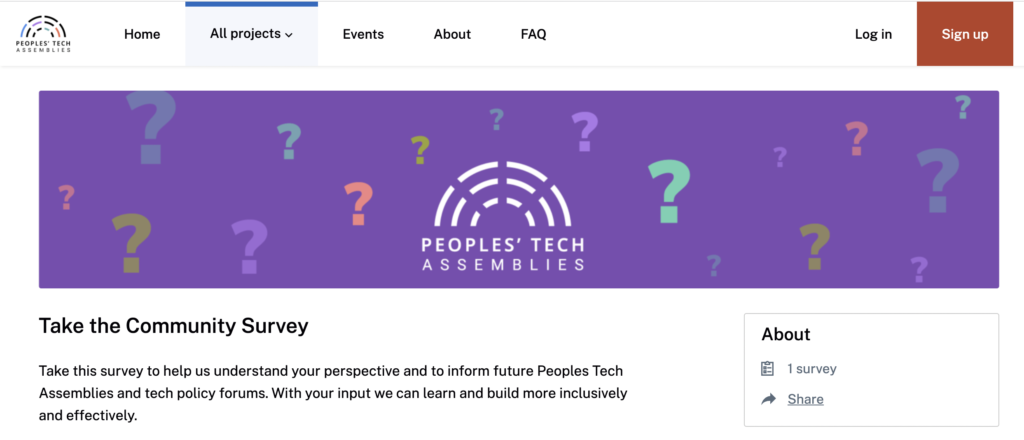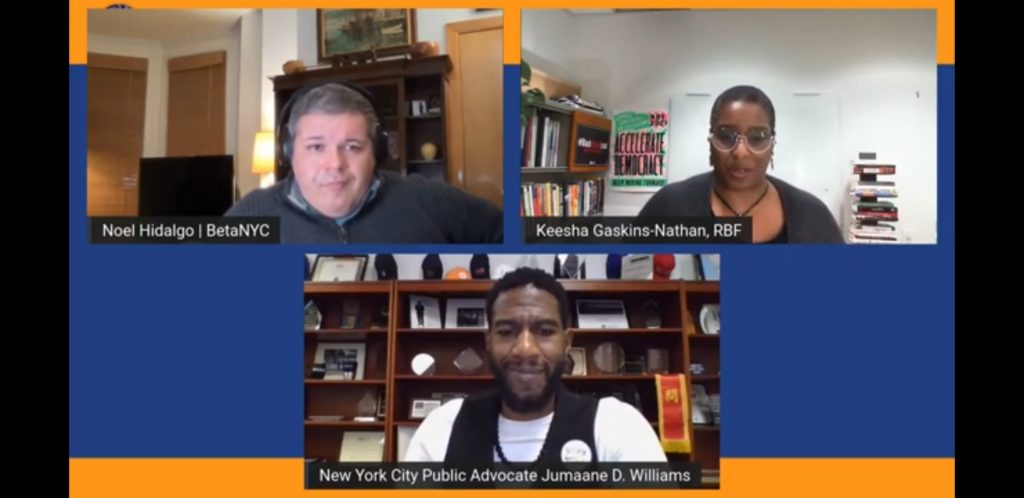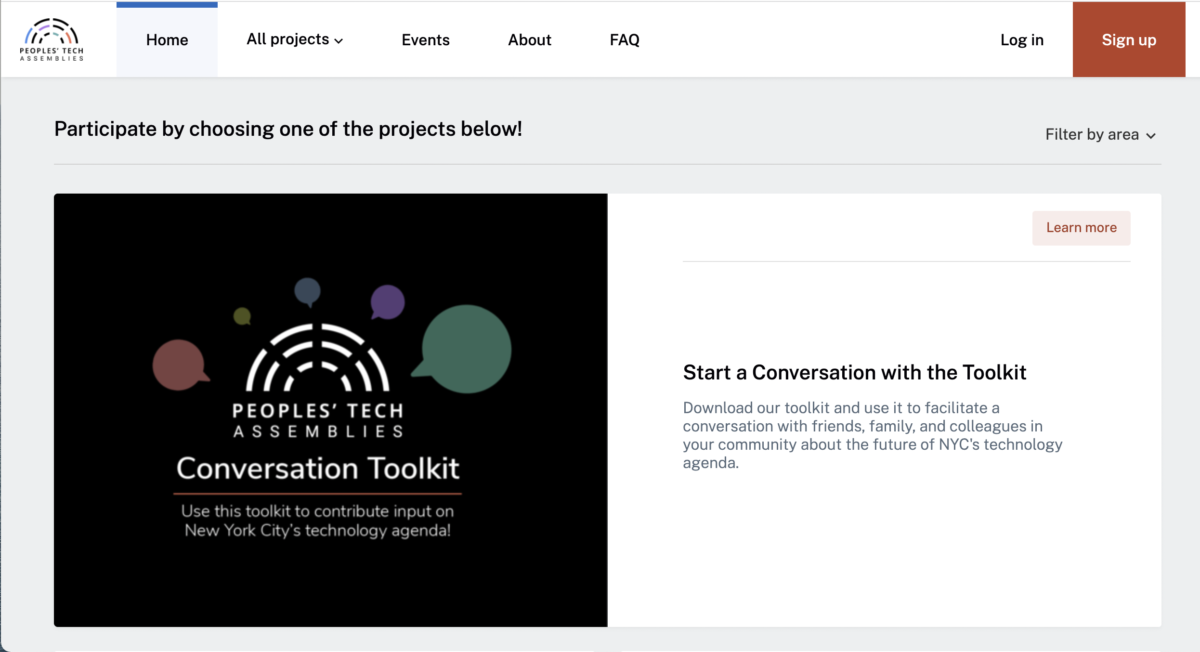Introduction
This is a hefty update on the NYC Peoples’ Tech Assemblies and our efforts to update the People’s Roadmap to a Digital New York City.
Index:
The BetaNYC team is in awe of how quickly 2021 zipped by! For two years, you have slogged through hack after hack demonstrating the need for an engaged civic technology community. Your work on maps, apps, or volunteering for your local mutual aid organization is a testament to our collective desire to make this a better city. Last August, we announced the NYC Peoples’ Tech Assemblies to gather your input on how to move forward.
With it difficult to convene for in-person policy discussions, we investigated new methodologies for civic engagement. Our online platform served as a way to collect questions and ideas on how technology plays a role in our daily lives.
The NYC Peoples’ Tech Assemblies is a series of engagements via online forums, public events, a community survey and facilitated conversations for us to share our voices on how the government implements technology and how we as New Yorkers experience it.
The initiative’s goals:
- Inspire New Yorkers and incoming New York City government decision makers to think big and tread boldly
- Define a new process for New York City government to engage with and understand New Yorkers’ experiences in order to implement technology more fairly and effectively.
For four months, we hosted public events and developed four mechanisms for neighbors to provide their thoughts, feedback and proposals on the ever-evolving New York City civic tech. As of this writing, our primary ways of collecting your ideas have been through public events, our community survey, online conversations and our conversation toolkit.
The NYC Peoples’ Tech Assemblies Stats:
| Breakdown of public input collection* | 612 total 191 from public events 421 from community survey |
| # of people on engagement platform** | 159 |
| # of events** | 7 on online platform |
| # of survey responses** | 121 |
**Metrics from August 23 – December 31 2021
The People’s Roadmap – 8 Years Later
Many of the processes we used within the NYC Peoples’ Tech Assemblies echoed a civic engagement program we ran with Code for America and NYC Digital, which was the precursor to the NYC Mayor’s Office of the Chief Technology Officer. These public meetings led NYC Digital to publish its last “Tech Roadmap” and for BetaNYC to publish The 2013 People’s Roadmap to a Digital New York City. By meeting and discussing ideas, we created actionable opportunities.
The 2013 Roadmap resulted in a series of groundbreaking laws centered around government transparency, open data, and launched programs that developed civic participation. It has enhanced NYC’s open data program, while providing community boards with more resources for engagement. Specifically, we got participatory budgeting to be expanded into the municipal budget, the City Charter and City Record to be put online as well as increased accessibility to the City’s Freedom of Information Law. At BetaNYC, we created the Civic Innovation Fellowship and Apprentice program to train a new generation of public interest technology professionals and launched a tech support process to meet the diverse civic tech needs of our neighborhoods.
Read in detail how we have tracked each 2013 Roadmap recommendation.
In short, it has been a tremendous eight years since the original People’s Roadmap was published. Now, we plan to leverage your ideas for a new People’s Roadmap. Your ideas will provide newly elected Council Members and other municipal leaders with the ideas they need to navigate, design and implement services in New York City.
Preliminary Analysis – What Did we Learn from the Peoples’ Tech Assemblies?

We needed a way to gauge our initiative’s effectiveness. In November, we conducted a preliminary analysis. Below are the results of our preliminary analysis; we will do a closing analysis by early May.
Our main objectives for the analysis were the following:
- Assess data quality
- Pilot a process for our data synthesis and analysis to inform our secondary analysis later this year
- Identify insights to share
There were three stages to our preliminary analysis:
- First, we suggested edits and additions to the Urban Tech Hub at the Jacobs Cornell-Technion Institute’s recently updated Rebooting NYC report.
- In the second round, we codified public inputs.
- In the final stage, we conducted a deeper analysis of our findings from the second round and summarized our findings into the recap section below.
After compiling the initial data, we made recommendations for the Jacobs Cornell-Technion Institute’s Rebooting NYC report. Here is a summary of three of the Jacobs Cornell-Technion Institute’s recommendations for the new administration, along with our inputs that appeared in the final report.
Data Locker — create a “data locker” so New Yorkers can conveniently access digital social services. Regarding the “data locker,” we shared that all residents should be able to access and download their documentation easily. In addition, the UX design needs to be leveraged to meet the needs of all New Yorkers (p.119-123 in the report).
Accessible Community Board Meetings — community board meetings can improve accessibility by implementing automatic transcriptions, captions and translations. In addition, we encouraged accessibility resources to be placed into a central library for all municipal public meetings (p. 132-133 in the report).
Safe Streets — utilize digital enforcement and management to establish safe streets. As a response, we suggested deploying such technology in an equitable way that is also mindful of new mobility users, such as people on bikes (p.58 in the report).
Here is a summary of preliminary findings:
Through this process, 20% of your responses were linked to Infrastructure and Environmental Justice, 18% were related to Effective and Open Government and 13% were connected to Education and Opportunity.
With a further breakdown of these themes, you expressed your desire for a focus on effectiveness, investment, accessibility and transparency. And through your responses, you wanted to identify issues and suggest proposals.
Here is a breakdown of your top issues:
Your pinpointed issues focusing on Housing Equity and Infrastructure and Environmental Justice.
One of our events focused on public housing and featured subject matter experts. The event drew people to discuss NYCHA and prioritized emphasizing housing-related issues. As a result, the bulk of the issues you identified centered on housing equity.
Those top 5 issues could be refined into:
- Economic diversity concerns and gentrification
- Unaffordable housing
- Eviction concerns
- Questions about stakeholders and their incentives
- Issues with housing related government websites and services
For Infrastructure and Environmental Justice, the top 5 issues you identified were:
- Air and water quality, and that public green spaces need to be improved and monitored across the 5 boroughs, but especially in poorer communities.
- We need accessible bike lanes that are not blocked by cars and overall public transportation advancements.
- We need to enable better pedestrian flow, especially for people in wheelchairs and stroller users by addressing trash on sidewalks.
- The city wi-fi is not effective. It slows the computers down when it rains, snows, and in extreme hot climates.
- There are not enough benches or places for seniors and other people with mobility issues to rest while running errands.
Here is a breakdown of your proposals:
You informed us that you wanted to see action around Infrastructure and Environmental Justice and Effective and Open Government.
For Infrastructure and Environmental Justice, some of the requests you’ve shared are:
- Transparency on transit inequity
- More rain gardens and plant beds
- Renovate buildings for energy efficiency as a way of combating global warming
- Curbing car traffic and creating more designated structures for bicycle parking
- Using sensors to address air pollution and air quality issues
- Invest in modern infrastructure with more bus lanes and preventing networks from crashing
- Increase availability and connectivity of free wifi regardless of income
And for Effective and Open Government, the ideas you submitted were:
- Agencies need to follow up with people after they use their services. This means being transparent on tech practices and having better messaging on services.
- Implement user testing with sectors of the population with less technical literacy and pay them for it.
- People should be able to contribute to what occurs in government, not just politicians; New Yorkers should be given the tools to participate in the redistricting process, as well as receive relevant data.
- We need a website with the information of all people and companies doing business with the city. Each borough should have their own website which lists upcoming events, especially election/voting dates.
- We should improve GIS technology with regards to city landscape, services or infrastructure.
- Ensuring universal access to services, not just online – also, do not let technology replace real people and government services.
- Move city government operations off the cloud and strive for technological independence by building a bunch of servers and our own broadband network.
- Build a professional digital services corps/agency for a better citizen experience.
Final Words: Reflections and Looking Forward

We live in a society with a digital divide and massive inequalities that govern who can participate in our democratic society, participate in hours-long meetings and advocate for themselves. All these factors existed long before the pandemic, and have amplified over the past two years. We acknowledge that our way of collecting input did leave out some people. We take full ownership of that. In this new reality, we set out to learn and collect feedback.
Our preliminary analysis illustrates a need for measurement and adaptability prior to concluding a virtual civic engagement process. In addition, our project was launched in an election year in the midst of a blackout period, creating multiple engagement barriers. As the global pandemic has changed our lives, we need to alter our civic engagement strategies.
Our data is a small sample size and does not represent the New York City population; we have never claimed to represent a general population. Factors such as the digital divide, question formatting in our public events and frequently updating our synthesis process also impacted our results. However, we still needed to present our preliminary findings as you shared some wonderful insights, and this milestone will guide us to improving our secondary analysis.
By the conclusion of this project, we will modify the original People’s Roadmap and outline an updated vision of New York City for our digital era. Additionally, we will create a snapshot resource that will serve as an unofficial onboarding guide to the New York City civic tech sphere.
It has been quite the journey so far and we’re not done yet! We can’t wait to share the final results with you! To the new administration – welcome! We are looking forward to collaborating with you to create a better city for all.
Your Next Steps – Stay in Touch!
Sign up for the Peoples’ Tech Assemblies newsletter. In the coming months, we’ll publish the People’s Roadmap, be sure to sign up to find out more!
Thank you to our partners!
Thank you to our partners and to everyone who is part of the NYC Peoples’ Tech Assemblies and has helped spread the word! We are beyond grateful to know wonderful community members such as yourselves. Here’s to a fruitful new year! Cheers!
- The New York City Office of the Public Advocate
- The Office of the Manhattan Borough President
- New America’s Public Interest Technology team
- The Urban Tech Hub at the Jacobs Cornell-Technion Institute
- The College of Staten Island
- CivStart
- Volunteer advisor Ariel Kennan
- CitizenLab
- And a collection of individual advisers and facilitators!
Glossary
We created a glossary to navigate the insights for our preliminary analysis.
| Term | Definition and Categories |
| Input type | Our way of categorizing your feedback: Issue: A grievance without a need identified / an observation Need: What should happen. An issue that has been framed in terms of a user. Challenge Statement: Actionable User Story framing the solution space. A more contextualized need. Proposal: A solution or recommendation for solving something. Experience: an opinion/observation, usually positive, doesn’t offer a solution |
| Peoples’ Tech Assemblies topic | Our seven thematic areas: Civic and Community Empowerment Education and Opportunity Effective and Open Government Housing Equity Infrastructure and Environmental Justice Justice, Health Equity and Safety Smarter Communities |
| Public input | In short, this is what we call your feedback. |
| Theme/Buckets | Team-defined categories for public input and input type collectively: Transparency Accessibility Accountability Effectiveness Investment Collaboration Equity Harassment Prioritize locals Literacy Culture Privacy Misaligned incentives Tech isn’t the solution Experiences with Tech |
